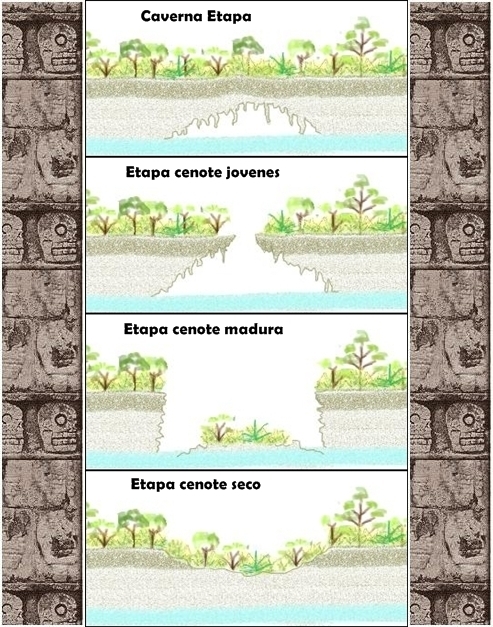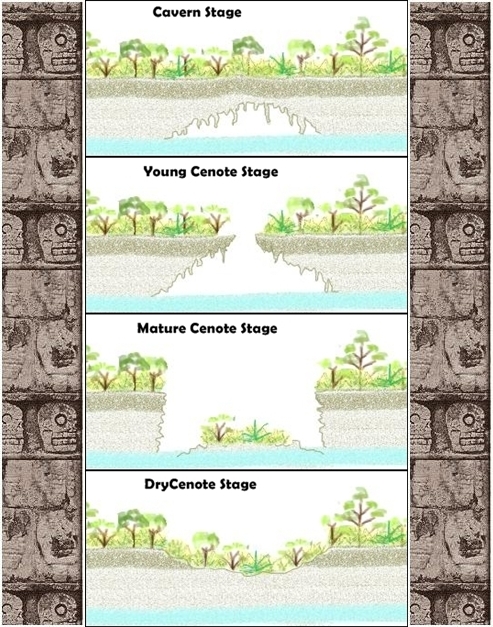 
Un cenote (del maya ts'ono'ot: caverna con agua) es una dolina
inundada de origen kárstico que se encuentra en algunas
cavernas profundas, como consecuencia de haberse derrumbado
el techo de una o varias cuevas.
Ahí se juntan las aguas subterráneas, formando un estanque
más o menos profundo. Existen varios tipos de cenotes: a cielo abierto,
semiabiertos y subterráneos o en gruta. Esta clasificación está
directamente relacionada con la edad del cenote,
siendo los cenotes maduros aquellos que se encuentran completamente
abiertos y los más jóvenes los que todavía conservan su
cúpula intacta. Como otras muchas estructuras geomorfológicas,
los cenotes son estructuras transitorias, que finalmente pueden
terminar rellenos y desecados, pasando a formar parte de lo que se
conoce como un paleokarst.
Su morfología suele ser típicamente subcircular, y con las paredes
abruptas. Por la evolución del macizo kárstico, el cenote
comienza siendo una cámara subterránea producida por la
disolución de la roca caliza por la infiltración del agua de lluvia.
Finalmente, conforme la cavidad va aumentando de tamaño,
el cenote puede terminar aflorando a la superficie por colapso de la cúpula.
Los cenotes se formaron durante las épocas de bajada del nivel del mar
durante los pulsos glaciares del Pleistoceno.
Los cenotes son, en la mayor parte de los casos, ensanchamientos de complejas
redes fluviales subterráneas, que en ocasiones se abren paso hasta el mar.
En éstos, el agua marina, más densa que la dulce, puede penetrar por
el el fondo del sistema freático. Por ello, hay cenotes en los que a partir
de determinada profundidad el agua pasa de dulce a salada, incluso
a muchos kilómetros de la costa.
Esta superficie de contacto entre el agua dulce y marina
recibe el nombre de haloclina, y provoca interesantes efectos visuales.
Etapas en la formacion de cenotes

( Copyright "Cenote Stage Pictures" Luca Ridarelli )
Aprender mas acerca de Cenote http://www.ridarelli.net/cenotes/english/index.htm
El Cenote Sagrado de Chichen Itzá mide sesenta y cinco metros de
diámetro y treinta y cinco de profundidad. Ese sitio era el corazón
de las actividades religiosas de toda la zona maya.
Como parte del culto al dios del agua, los mayas arrojaban ofrendas
ceremoniales que consistían; principalmente, en objetos
preciosos como piezas de oro, jade, cobre, tela y cestería.
Este lugar tenía un papel tan importante dentro de la cosmogonía
maya que, siglos después de la decadencia de Chichen Itzá,
se hacían peregrinaciones para rendir culto a los dioses en ese lugar.
Algunos investigadores creen que el Cenote Sagrado se utilizaba para
sacrificios; así los objetos eran lanzados por doncellas.
En 1901 el estadounidense Edward Thompson, dragó el pozo y en él
encontró joyería, cerámica, figuras de barro y huesos de seres humanos,
principalmente niños. Tras examinar la evidencia concluyó que era
más factible que esas personas hubieran muerto ahogadas
por accidente que con fines religiosos.
|
|
 
The underground river systems of the Yucatan flow beneath
the entire peninsula. During the ice ages when the ocean levels
were much lower than they are today,what was once a giant
coral reef became exposed to the atmosphere and eventually became
the Yucatan Peninsula. Massive cave systems were formed by gradual
dissolving of the highly porous coral limestone.These caves are called
"solution caves" because they were formed by the slightly acidic
rainfall dissolving the alkaline limestone.Inside the caves the geological
formations such as stalactites and stalagmites are a spectacular sight to see.
Many of the caverns eventually collapsed and the sea levels rose
partially or completely flooding the cave systems.The water table
of the entire peninsulais filled with consists of seawater at sea level
and freshwater 'floating' on top at varying depth depending
on the distance from the sea.
Stages in the formation of cenote

( Copyright "Cenote Stage Pictures" Luca Ridarelli )
Learn more about cenotes http://www.ridarelli.net/cenotes/english/index.htm
Cenotes are complexes of sinkholes and caves in the Karst geological
landscape of the Yucatán. Some cenotes contain spectacular cave formations,
while others are important archaeological sites,and several were considered
sacred by the Mayans. A few are open to the public for swimming and
diving. Of the estimated 30,000 cenotes, many of them unexplored, many are
considered to be Mayan cultural and archaeological sites.Ancient fossilized
remains of Camels, giant Jaguars and Mammoths are among the interesting
archaeological finds in recent years.
One of the most impressive is the Cenote Sagrado, which is 60 metres (200 ft)
in diameter, and sheer cliffs that drop to the water table some 27 metres
(89 ft) below. The Cenote Sagrado was a place of pilgrimage
for ancient Maya people who, according to ethno historic sources,
would conduct sacrifices during times of drought.
Archaeological investigations support this as thousands of objects have
been removed from the bottom of the cenote, including material such
as gold, jade,obsidian, shell, wood, cloth, as well as skeletons
of children and men.
( source: wikipedia.org, wikitravel.org, ridarelli.net )
|
|
Log Requirements  
You may log this cache and email the answers at the same time.
Logs containing any answers to questions will be deleted.
1. Describe the walls of the cenote!
Make a small drawing and paste it to the log! (optional)
2. What color is the water of the cenote?
3. Describe a plant species at the edge!
4. This cenote was once a place of sacrifice. Describe your feelings regarding this fact.
5. Send me an e-mail with the answers to 1,2,3 and 4.
6. Upload two photos from you or your gps-device
*at the pyramid - castillo / * near the cenote (optional)
|